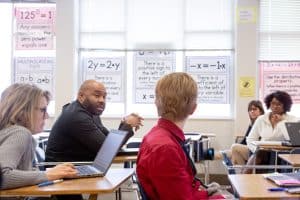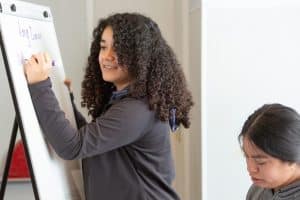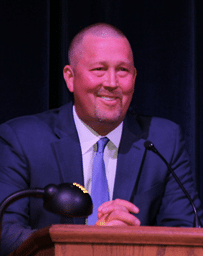Educator Support in Competency-Based Learning Schools
CompetencyWorks Blog
As our profession emerges from the shadows of the global pandemic, there is a renewed interest by schools in developing and/or expanding the use of competency-based learning (CBL) systems to ensure high levels of learning for all students. This work requires a significant level of dedication and commitment by all educators in a school over a period of several years. Highly effective classroom teachers are critical, but what does it mean to be a highly effective educator in a CBL school?
As veteran school administrators in competency-based schools, we have come to understand how important educator recruitment and ongoing educator professional development are to sustaining the work long-term. When we work with schools around the country on this topic, we coach school leaders on the following strategies to ensure they recruit educators to advance the work and provide them with support to be successful as they grow.

1. Educators cannot do the work in silos.
Strong CBL schools are organized into a professional learning community of highly effective collaborative teams – groups of educators working interdependently and holding themselves mutually accountable as a team for the success of each of the students that they serve. These teams calibrate their understanding of the competencies, essential standards, and learning targets within their grade-level and/or content-area curriculum. They have a shared understanding of what mastery/proficiency is, and the way(s) in which students can and should demonstrate evidence of their learning. They work as a team to implement targeted and timely interventions, extensions, and enrichments for each student as they are needed throughout the learning process. CBL schools invest deeply in time and resources designed to help establish collaborative teams. They continue to push them to refine and deepen their work, never settling for the status quo. In CBL schools, there is a collaborative professional culture that permeates all aspects of school operations.
2. Assessment literacy by each and every educator on a collaborative team must deepen as the work deepens.

A balanced assessment system that includes common diagnostic, formative, and summative components is a must. When we coach collaborative teams, we ask them to consider how they can make better use of assessment as a tool that provides teachers and learners with feedback on where students are and engages students in a positive way within the assessment process. We ask teams to consider how they can use both ongoing formative assessment practices on a day-to-day basis and common formative assessment data to adjust their instruction and group students to better focus their support to better enhance student learning. We ask teams to reflect on the ways in which they collect quality summative evidence – ideally with performance assessments – that demonstrates deeper learning. We see the evolution of assessment literacy by collaborative teams to be the linchpin to the development of a highly effective CBL system. Understanding precisely where students are in their learning, and even more importantly, supporting students in understanding where they are and what they need to do next, is critically important. We remind veteran educators that oftentimes the assessments they need will look different from the “tried and true” ones that they may have used in the past. We caution new educators to not be discouraged by a lack of experience when designing assessments, but rather to lean on the expertise of their collaborative team members and stay focused on designing assessments that are aligned with the competencies, skills, and dispositions that they are teaching.
3. There is no substitute for quality instruction.

Quality instruction must be delivered to foster the ongoing development of skills on the road to mastery by every student. Educators in CBL schools understand that there is no “one size fits all” approach to learning a new skill, but that it is imperative that teaching teams understand the progressions to mastering a standard. They also understand that if the ultimate goal is for students to be able to apply and transfer their learning in new ways, they have to provide opportunities for students to practice, reflect, and develop these skills over time and in different contexts. When assessment practices indicate that a student needs intervention, the instructional strategies used by the educator must be timely and focused and ultimately support the particular skill or learning target that needs remediation. Through ongoing monitoring, if the team determines that this strategy isn’t working, another must be implemented.
When a student demonstrates mastery and is ready for extension and enrichment, it must be provided in a way that helps the student advance and deepens their learning. The single best way to sustain quality instruction across a school is to make it a priority focus for professional learning community collaborative team discussions and decisions. As teams deepen their work, they will find that they seek out better instructional strategies from each other. Individual teachers on collaborative teams will become more reflective on the practices that they use to promote better student achievement and will share these practices as a part of their ongoing collaboration. This cycle will continue to sustain the work for the long term.
4. School leadership must be distributed.
Strong instructional leaders constantly identify and invest in educators who can serve as teacher leaders to advance the work in the school. Simply put, this work cannot be done in a top-down manner, and for the changes to persist, the ownership must be dispersed throughout the school. This process reflects a culture of continuous learning and one in which the mission, vision, values, and goals are pillars that everyone not only understands but helped to create. Implementing a distributed leadership model within a school is a process, something that can be challenging for many administrators (especially) because they feel a level of urgency and pressure to “make change” immediately.
In our work with many schools and districts, providing support to create, develop, and/or sustain this team has proven to be a game-changer. In fact, we have found that it is the single most important structure for change in the school. A collaborative leadership team’s ongoing collaboration determines the pathway forward in a school. It is also a venue for practicing many of the processes that lead to greater collaboration at the grade level or content-team level. The building leadership team (or guiding coalition) allows teacher leaders the opportunity to practice and hone their skills in a safe, supportive environment.
5. The work never ends.

Educators in highly effective CBL schools are constantly reflecting on what they must do to be more responsive to student needs. They actively seek new and better ways to help all students take ownership of their learning and deepen it over time. They look for opportunities to increase equity for all students at all levels of the system. They rely on their collaborative teammates to constantly push their thinking in new ways and hold them accountable for continuous improvement.
We have a number of tools and resources in our latest book, Unpacking the Competency-Based Classroom: Equitable, Individualized Learning in a PLC at Work® (2022), that can assist school leaders and educators on their journey. The most notable, and one that is highlighted as a key resource within the ongoing CBE Starter Pack series by Laurie Gagnon, is a competency-based learning school design rubric, which can provide both a compass and a roadmap to stay committed to the work. This rubric was developed and refined with input from educators across North America to support the seven design principles of competency education developed by the Aurora Institute. The rubric can be used as both a self-assessment and also as a way to develop a strategic plan with action steps to advance the work.
Quality educators are the most critical asset in a school for sustaining the work over time. These educators must be committed to doing the right work with their collaborative team, but they also must be supported by school leaders who will stand beside them. Educators need time to do the work, and they need ongoing professional development to push their thinking and help them answer the deeper questions that they will identify in their pursuit of ensuring that all students learn at high levels. Committing to the process and being agile in how and when support is provided will ultimately best sustain a school as it undertakes the journey to becoming a highly effective competency-based learning system.
Learn More
- Implementing Competency-Based Education in Your School or District: A Tool to Help You Chart Your Journey
- Diving into a Deep Blue(grass) Sea of Innovation, Part Two: Early Lessons Learned When Implementing Multi-District Deeper Learning in Kentucky
- Building 21’s Leadership Competencies to Facilitate Competency-Based Learning

 Brian M. Stack and Jonathan G. Vander Els, former school administrators in New Hampshire, are the coauthors of two books on competency-based learning: Breaking With Tradition: The Shift to Competency-Based Learning in PLCs at Work™ (2017) and Unpacking the Competency-Based Classroom: Equitable, Individualized Learning in a PLC at Work® (2022), both published by Solution Tree. They work with educators around the country through their roles with three organizations. They are partners and lead associates of V&S School Solutions, a company that provides professional development services and support in the area of competency-based learning, structures to support personalized learning and assessment, and leadership development to schools around the country. They are associates for Solution Tree, a global professional development provider. Lastly, they are project directors at the New Hampshire Learning Initiative, a nonprofit organization that is committed to moving schools forward through meaningful educational change and providing all students with accessible learning pathways to success in college, career, and life. You can follow Brian and Jon on Twitter at @bstackbu and @jvanderels.
Brian M. Stack and Jonathan G. Vander Els, former school administrators in New Hampshire, are the coauthors of two books on competency-based learning: Breaking With Tradition: The Shift to Competency-Based Learning in PLCs at Work™ (2017) and Unpacking the Competency-Based Classroom: Equitable, Individualized Learning in a PLC at Work® (2022), both published by Solution Tree. They work with educators around the country through their roles with three organizations. They are partners and lead associates of V&S School Solutions, a company that provides professional development services and support in the area of competency-based learning, structures to support personalized learning and assessment, and leadership development to schools around the country. They are associates for Solution Tree, a global professional development provider. Lastly, they are project directors at the New Hampshire Learning Initiative, a nonprofit organization that is committed to moving schools forward through meaningful educational change and providing all students with accessible learning pathways to success in college, career, and life. You can follow Brian and Jon on Twitter at @bstackbu and @jvanderels.